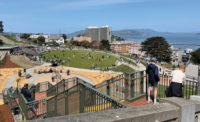Spokane Riverfront Park U.S. Pavilion | Submitted by Hill International Inc.
Spokane, Wash.
Region: ENR Northwest
Owner: City of Spokane Parks and Recreation Dept.
Owner’s Representative: Hill International Inc.
Lead Design Firm: NAC Architecture
General Contractor: Garco Construction
Civil Engineer: Jacobs
MEP Engineer: MW Consulting Engineers
Structural Engineer: DCI Engineers
Landscape Architect: Berger Partnership
Subcontractors: NAC Electrical & Lighting; Mackin & Little Inc.; Apollo Mechanical Contractors; Power City Electric Inc.; GuildWorks LLC; Modern Drywall Inc.; Elder Demolition Inc.; S&S Coatings Inc.; Cameron-Reilly LLC; Land Expressions LLC
The U.S. Pavilion in Riverfront Park in Spokane, Wash.—with its 150-ft-tall angled mast supporting a 50-ft-dia steel ring—was iconic. It served as the site of Expo ’74, but four decades later, it was in need of a major overhaul.
The master plan proposed that the U.S. Pavilion “be a lantern for Riverfront Park and the community,” says Matthew Walker, Hill International vice president. The design gave that goal a figurative and literal meaning.
A $2-million contract bump led to three central features. Weatherproof acrylic panels containing remotely powered LED lights were added to the pavilion’s original cable net structure to create the “Illuminated Experience.” “The application of this type of LED technology was the first of its kind,” says Walker of the NAC Architecture/ Power City Electric design.
The concrete columns and platforms that comprised the above-ground pathways of the “Elevated Experience” were self-performed by general contractor Garco Construction, which came up with the original concept. To reduce elevated work time, the contractor site-cast the elements on the ground before lifting them into place, an example of decisions that led to a lost-time and OSHA recordable incident rate of zero.
The sun shade structure involved affixing 72 custom-built tensioned panels to the cable net to provide comfort during the daytime. Expanded event capacity was a change introduced seven months before construction was completed, the last in a series of changes that set the original schedule back by just three months, which Walker attributes to the “problem-solving flexibility” and collaborative nature of design-build.







Post a comment to this article
Report Abusive Comment